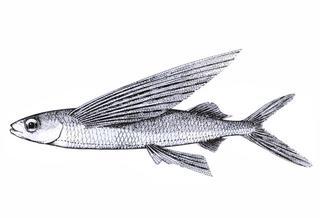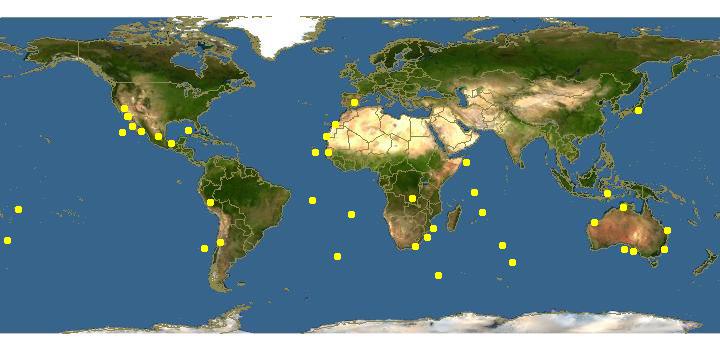
www.fao.org Copyright Michel Lamboeuf · 0
Cheilopogon pinnatibarbatus californicus |

Click on map for details about points.
|
| Links |
We parsed the following live from the Web into this page. Such content is managed by its original site and not cached on Discover Life. Please send feedback and corrections directly to the source. See original regarding copyrights and terms of use.
- Australian Faunal Directory
- FishBase
|
|
espa˝ol |
|
|
Overview |
Main identification features
- d: large dark spot
- pectoral - grey + broad clear margin
- pectoral reaches tail fin base
- pelvic long, origin nearer operculum than c
Body relatively slender (depth <16% of standard length); head relatively short (<22% of standard length); snout short (~eye diameter); lower jaw not shorter than top jaw; jaw teeth very evident; dorsal fin 9-13; pectoral fin reaches base of tail fin, its1st ray unbranched; pelvic fin reaches nearly to end of anal fin base, its insertion is nearer the rear edge of the opercle than the base of tail fin; anal fin 9-12, its origin below about 3rd dorsal fin ray; ~50 scales between dorsal fin and front of head
Blue-grey above, silvery below; dorsal with a large dark spot; pectorals dark grey with a wide clear border; remaining fins clear
Size: reaches 48 cm.
Habitat: surface layers inshore and offshore.
Depth: 0-10 m.
Oregon to the tip of Baja California, the SW Gulf of California, also the Revillagigedos Islands.
Attributes
Abundance: Common.
Cites: Not listed.
Climate Zone: North Temperate (Californian Province &/or Northern Gulf of California); Northern Subtropical (Cortez Province + Sinaloan Gap); Northern Tropical (Mexican Province to Nicaragua + Revillagigedos).
Depth Range Max: 10 m.
Depth Range Min: 0 m.
Diet: zooplankton; pelagic fish larvae; pelagic fish eggs.
Eastern Pacific Range: Northern limit=33; Southern limit=19; Western limit=-118; Eastern limit=-110; Latitudinal range=14; Longitudinal range=8.
Egg Type: Pelagic; Pelagic larva.
Feeding Group: Planktivore.
FishBase Habitat: Pelagic.
Global Endemism: TEP non-endemic; East Pacific endemic; All species.
Habitat: Water column.
Inshore Offshore: Offshore; Offshore Only.
IUCN Red List: Not evaluated / Listed.
Length Max: 48 cm.
Regional Endemism: Island (s); Continent; Temperate Eastern Pacific, primarily; Continent + Island (s); Tropical Eastern Pacific (TEP) non-endemic; California province, primarily; All species.
Residency: Vagrant.
Salinity: Marine; Marine Only.
Water Column Position: Surface; Water column only;
|
|
|
Names | |
|
|
|
Links to other sites | |
|
|
|
References |
- Castro-Aguirre, J.L. and Balart, E.F., 2002., La ictiofauna de las islas Revillagigedos y sus relaciones zoogeograficas, con comentarios acerca de su origen y evolucion. En: Lozano-Vilano, M. L. (Ed.). Libro Jubilar en Honor al Dr. Salvador Contreras Balderas., Universidad Autonoma de Nuevo Leˇn:153-170.
- Cooper, J. G., 1863., On new genera and species of Californian fishes--No. II., Proceedings of the California Academy of Sciences (Series 1), 3:93-97.
- Findley, L.T., Hendrickx, M.E., Brusca, R.C., van der Heiden, A.M., Hastings, P.A., Torre, J., 2003., Diversidad de la Macrofauna Marina del Golfo de California, Mexico., CD-ROM versiˇn 1.0. Projecto de la Macrofauna del Golfo .á Derechos reservados de los autores y Conservaciˇn Internacional.
- Fischer , W. , Krup , F. , Schneider , W. , Sommer , C. , Carpenter , K. E. and Niem, V. H., 1995., Guia FAO para la Identificacion de Especies de para los fines de la Pesca. Pacifico Centro-Oriental. Volumen II. Vertebrados - Parte 1., FAO2:647-1200.
- Fowler, H.W., 1944., Results of the Fifth George Vanderbilt Expedition (1941) (Bahamas, Caribbean sea, Panama, Galapagos Archipelago and Mexican Pacific Islands). The Fishes., Acad. Nat. Sci. Philadel., Monographs, 6:57-529.
- Gotshall, D.W., 1996., Fishes of Rocas Alijos. In Rocas Alijos. Ed. R. W. Schmieder. Cornell Expeditions., Kluwer Academic Publishers: 347-354.
- Lopez , M. I. and Bussing, W. A., 1982., Lista provisional de los peces marinos de la Costa Rica., Revista de Biologia Tropical, 30(1):5-26.
- Love, M.S., Mecklenburg, C.W., Mecklenburg, T.A., Thorsteinson, L.K., 2005., es of the West Coast and Alaska: a checklist of North Pacific and Artic Ocena species from Baja California to the Alaska-Yukon border., U.S. Department of the Interior, U.S. Geological Survey, Biological Resources Division, 288pp.
- Van der Heiden , A. M. and Findley, L. T., 1988., Lista de los peces marinos del sur de Sinaloa, MÚxico., Anales del Centro de Ciencias del Mar y Limnologia de la Universidad Autonoma Nacional de Mexico, 15:209-224.
|
|
|
Acknowledgements | |
I thank Ashley MacDonald and John Pickering, University of Georgia, for technical support in building this page.
|
|
| Supported by | |
|
Following modified from Australian Faunal Directory
|
Top | See original
| &pull 20q v5.145 20180528: Error 301 Moved Permanently http://biodiversity.org.au/afd/taxa/f0088553-39c3-4538-b0fc-0e3e20394a83 |
|
Following modified from FishBase
|
Top | See original
http://www.fishbase.org/Summary/speciesSummary.php?genusname=Cheilopogon&speciesname=pinnatibarbatus ---> http://192.134.151.83/Summary/speciesSummary.php?genusname=Cheilopogon&speciesname=pinnatibarbatus
http://192.134.151.83/Summary/speciesSummary.php?genusname=Cheilopogon&speciesname=pinnatibarbatus ---> https://fishbase.mnhn.fr/Summary/speciesSummary.php?genusname=Cheilopogon&speciesname=pinnatibarbatus
https://fishbase.mnhn.fr/Summary/speciesSummary.php?genusname=Cheilopogon&speciesname=pinnatibarbatus ---> https://fishbase.mnhn.fr/summary/Cheilopogon-pinnatibarbatus.html
Cheilopogon pinnatibarbatus, Bennett's flyingfish : fisheries

You can
sponsor
this page
Common name (e.g. trout)
Genus + Species (e.g. Gadus morhua)
-

-
About this page
-
Languages
-
User feedbacks
-
Citation
-
Uploads
-
Related species
-


 Bennett's flyingfish
Upload your
photos
and
videos
Bennett's flyingfish
Upload your
photos
and
videos
Pictures
|
Stamps, Coins Misc.
|
Google image
 Cheilopogon pinnatibarbatus
Cheilopogon pinnatibarbatus
Picture by
FAO
Teleostei (teleosts) >
Beloniformes
(Needle fishes) >
Exocoetidae
(Flyingfishes)
Etymology:
Cheilopogon:
Greek, cheilos = lip + Greek, pogon = barbed, beard (Ref.
45335
)
.
More on author:
Bennett
.
Environment: milieu / climate zone / depth range / distribution range
Ecology
Marine; pelagic-neritic; oceanodromous (Ref.
51243
); depth range 0 - 10 m (Ref.
96339
). Tropical
Circumglobal: western Pacific as far north as southern Kuril Islands; Astoria, Oregon to southern Baja California and into Gulf of California.There are subspecies in most subtropical seas.
Size / Weight / Age
Maturity: L
m
?
range ? - ? cm
Max length : 40.0 cm SL male/unsexed; (Ref.
4498
)
Found in near-shore waters. Tends to occur near land or islands in cooler waters. Capable of leaping out of the water and gliding for long distances above the surface. Feeds on zooplankton and small fishes. Eggs with filaments over entire surface (Ref.
6523
).
Life cycle and mating behavior
Maturity
|
Reproduction
|
Spawning
|
Eggs
|
Fecundity
|
Larvae
Parin, N.V. and R.H. Gibbs Jr.
, 1990. Exocoetidae. p. 583-591. In J.C. Quero, J.C. Hureau, C. Karrer, A. Post and L. Saldanha (eds.) Check-list of the fishes of the eastern tropical Atlantic (CLOFETA). JNICT, Lisbon; SEI, Paris; and UNESCO, Paris. Vol. 2. (Ref.
4498
)
IUCN Red List Status (Ref.
130435
)
Least Concern (LC)
; Date assessed:
04 February 2009
CITES
Not Evaluated
Not Evaluated
Threat to humans
Harmless
Human uses
Fisheries: minor commercial
FAO - Publication:
search
|
FishSource
|
More information
Countries
FAO areas
Ecosystems
Occurrences
Introductions
Stocks
Ecology
Diet
Food items
Food consumption
Ration
Common names
Synonyms
Metabolism
Predators
Ecotoxicology
Reproduction
Maturity
Spawning
Spawning aggregation
Fecundity
Eggs
Egg development
Age/Size
Growth
Length-weight
Length-length
Length-frequencies
Morphometrics
Morphology
Larvae
Larval dynamics
Recruitment
Abundance
BRUVS
References
Aquaculture
Aquaculture profile
Strains
Genetics
Electrophoreses
Heritability
Diseases
Processing
Nutrients
Mass conversion
Collaborators
Pictures
Stamps, Coins Misc.
Sounds
Ciguatera
Speed
Swim. type
Gill area
Otoliths
Brains
Vision
Tools
E-book
|
Field guide
|
Length-frequency wizard
|
Life-history tool
|
Point map
|
Classification Tree
|
Catch-MSY
|
Special reports
Check for Aquarium maintenance
|
Check for Species Fact Sheets
|
Check for Aquaculture Fact Sheets
Download XML
Summary page
|
Point data
|
Common names
|
Photos
Internet sources
AFORO (otoliths) |
Aquatic Commons
|
BHL
|
Cloffa
|
BOLDSystems
|
Websites from users
|
Check FishWatcher
|
CISTI
|
Catalog of Fishes
:
genus
,
species
|
DiscoverLife
|
ECOTOX
| FAO - Publication:
search
|
Faunafri
| Fishipedia |
Fishtrace
| GenBank:
genome
,
nucleotide
| GloBI |
Google Books
|
Google Scholar
|
Google
| IGFA World Record |
MitoFish
|
National databases
|
Otolith Atlas of Taiwan Fishes
|
PubMed
| Reef Life Survey | Socotra Atlas |
Tree of Life
| Wikipedia:
Go
,
Search
| World Records Freshwater Fishing |
Zoological Record
Estimates based on models
Preferred temperature (Ref.
123201
): 19.5 - 27.6, mean 25.9 °C (based on 300 cells).
Phylogenetic diversity index (Ref.
82804
): PD
50
= 0.5000 [Uniqueness, from 0.5 = low to 2.0 = high].
Bayesian length-weight: a=0.00646 (0.00292 - 0.01429), b=3.04 (2.84 - 3.24), in cm total length, based on LWR estimates for this (Sub)family-body shape (Ref.
93245
).
Trophic level (Ref.
69278
): 4.0 ±0.65 se; based on food items.
Resilience (Ref.
120179
): High, minimum population doubling time less than 15 months (Preliminary K or Fecundity.).
Fishing Vulnerability (Ref.
59153
): Moderate vulnerability (39 of 100).
Price category (Ref.
80766
):
Medium
.
Back to Search
Random Species
Back to Top
Accessed through:
Not available
FishBase mirror site :
localhost
Page last modified by :
mrius-barile
- 20 July 2016
Fatal error
: Uncaught ArgumentCountError: Too few arguments to function checkEcotox(), 1 passed in /var/www/html/summary/speciessummary.php on line 2304 and exactly 3 expected in /var/www/html/includes/speciessummary.lib.php:2579 Stack trace: #0 /var/www/html/summary/speciessummary.php(2304): checkEcotox() #1 {main} thrown in
/var/www/html/includes/speciessummary.lib.php
on line
2579
|
Updated: 2024-04-20 00:13:40 gmt
|






